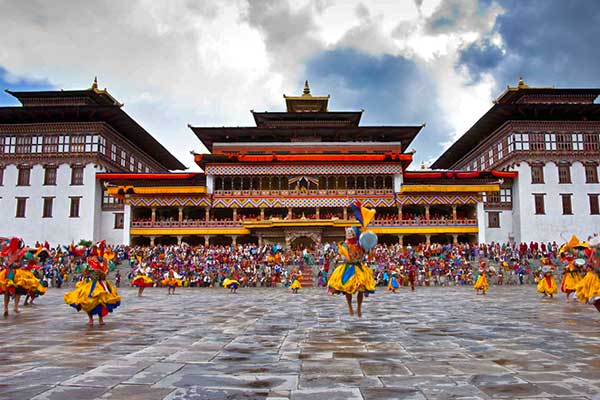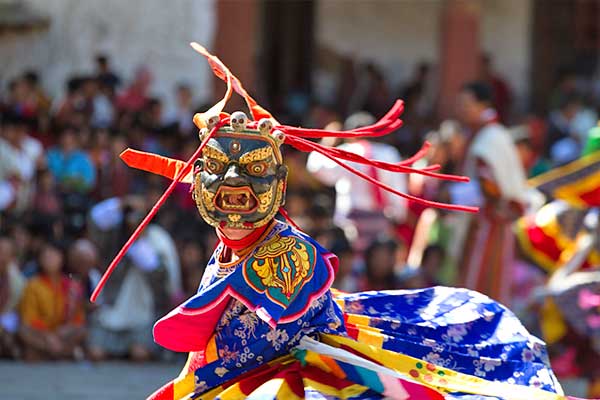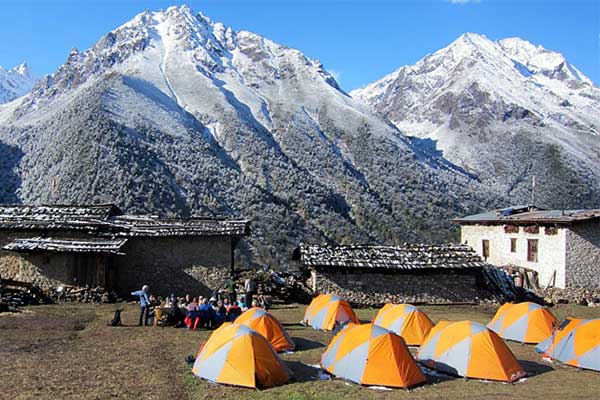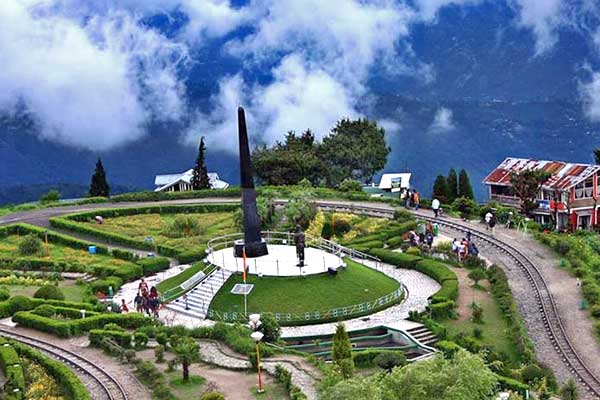Overview
Duration :
7 Days
Secondary Activity:
Culture
Max altitude :
Transportation:
International and Domestic Flights, Private Vehicle
Trip ends in:
Kathmandu
Accomodation:
Hotel
Primary activity:
Tour and Sightseeing
Group Size:
Min. 1
Country:
Bhutan
Trip starts from:
Kathmandu
Diffficulty:
Moderate
Meals:
Nepali, Continental and Bhutanese
Best Season:
All Seasons
Trip route:
Kathmandu - Paro - Thimpu - Punakha - Paro
Trip introduction
Bhutan tour is truly a heavenly tour for ageless culture and is considered as a standout among the most elite tourist destination on the planet. Thus, numerous commends Bhutan as the most joyful nation on the planet. Witness the exceptionally old Buddhist religious traditions, monasteries; traverse by some hill precipices and hike the rice paddies as you take a venture down the precarious slopes. Especially, exceptionally idea attracts inquisitive explorers, in spite of the high day by day duties forced on guests.
Remember your life and find the key to the wellspring of happiness as you navigate through this charming country of assorted common and social legacies. Experience Bhutan’s one-of-a-kind culture very close with farmhouse visits and town outings. Visit numerous social attractions including medieval fortifications (locally referred to as Dzongs), markets, and exhibition halls. Travelers get an unhinging moment to marvel at the detailed wall paintings, compositions, and carvings in Dzongs and other several sanctuaries. Lastly, climb up to the renowned Taktsang Monastery, roosted on a hill cliff located 900m over the valley floor.
Hence, contact Nepal Mountain Trekkers now to be a part of our Bhutan Tour. And take a reprieve from the daily stress of everyday life and work with our incredible tour services.
Special Note:
If this itinerary doesn’t suit your requirement or if you want to customize it, please feel free to contact us. This trek could be customized as per your required time-frame and budget limits.
Overview
-
Day 1Arrival at Kathmandu
-
Day 2Sightseeing and Tour Preparation
-
Day 3Fly Kathmandu to Paro and Drive to Thimpu
-
Day 4Thimphu to Punakha
-
Day 5Punakha to Paro
-
Day 6Paro Sightseeing
-
Day 7Departure
Detail Itinerary
Day 1 : Arrival at Kathmandu:
As soon as you arrive at the capital city, Kathmandu, you will be met by a representative from Nepal Mountain Trekkers at International Airport terminals and he will take you to your respective hotel (Hotel Green Horizon). After check-in at the hotel, you can enjoy your free time relaxing in a cozy room or stroll around the tourist hub Thamel area until the end of the day.
Day 2 : Sightseeing and Tour Preparation:
After having our early meal, we start our day with a visit to the Nepal Mountain Trekkers office at Thamel. After being introduced to our team including tour guide, trekking leader, and director of operations, we head for necessary trekking preparations, getting needed equipment with the initiation of Kathmandu sightseeing around world heritage sites. Kathmandu durbar square, Swayambhunath stupa, Pashupatinath temple, and Boudhanath stupa are UNESCO world heritage sites that we explore till sunset. Overnight stay at the hotel in Kathmandu. B included.
Day 3 : Fly Kathmandu to Paro and Drive to Thimpu:
As your flight lands in Paro. You will meet our representative at the airport and will be driven to Thimphu, Check-in hotel, and have lunch. After lunch, visit the Junshi paper factory. Handmade paper-making begins to find its place as the most important part of Bhutanese culture and tradition. Papermaking first began as a domestic occupation and is still preserved to these days. In the year 1990 the Government, Ministry of Trade and Industry established the Jungshi Handmade Paper Factory to act as a key pilot to safeguard the old tradition of handmade paper making in Bhutan and expand its market for commercial purposes. In 1992 the factory was privatized under the sole proprietorship of Mr. Norbu Tenzin, who was trained and sent as a missionary in Shimane Prefecture, Japan for high quality and designing of Bhutanese traditional handmade paper for the international market. After the paper, the factory drives up to the Kuenselphodrang to see the 165 ft tall bronze Buddha statue which overlooks the capital city of Bhutan, and later visits the Tashicheo Dzong. Overnight in Thimphu.
Day 4 : Thimphu to Punakha:
Today you will do Thimphu sightseeing till lunch. Memorial Chorten where the older people continuously circumambulated, murmuring mantras and spinning their prayer wheels. Construction of this landmark was the idea of Bhutan’s 3rd king, His Majesty Jigme Dorji Wangchuk (“the father of modern Bhutan”) who has wished to erect a monument to world peace and prosperity. Completed in 1974 after his untimely death, it serves both as a memorial to the Late King and as a monument to peace. Zorig Chusum (commonly known as the Painting School) where students undergo a 6-year training course in Bhutan’s 13 traditional arts and crafts. Later visit Folk Heritage Museum, a fascinating testimony of the Bhutanese material culture and living traditions. Phelchey Toenkhyim (Folk Heritage Museum), is dedicated to connecting people to the Bhutanese rural past through exhibits, demonstrations, educational programmed and documentation of rural life. The principal exhibit in the museum is a restored three-story traditional building, rammed with mud and timber, which dates back to the mid-19th century. In order to present a typical Bhutanese rural setting flavor, paddy, wheat, and millet fields, a traditional watermill (with millstones that dates back more than 150 years), traditional style kitchen gardens with vegetables that were grown and consumed over 100 years, and the famous hot stone bath complement the museum building and exhibition within. Takin, the national animal of Bhutan is said to be created by Lam Drukpa Kinley. After lunch drive to Punakha. Drive to Punakha(driving hour 2.30hrs), the old capital of Bhutan. Drive over a pass (Dochu-la 3150mtrs). La in Bhutanese means pass. There are 108 Chorten called “Druk Wangyel Chorten” with colorful prayer flags surrounding the area, which makes you fresh and feel peace. Visit the Druk Wangyel monastery. If the sky is clear this provides the best place to see and take photos of Himalayan snowcapped mountains ranges which borders Tibet(China), the following are the names of the peaks which can be seen from this pass (left to right): Masagang (7,158m), Tsendagang (6,960m), Terigang (7,060m), Jejegangphugang (7,158 m ), Kangphugang (7,170 m ), Zongphugang (7, 060 m ), a table mountain that dominates the isolated region of Lunana, finally Gangkar puensum, the highest peak in Bhutan at 7,497m.
After that, we drive down the hill till we feel the warm air of Punakha valley.
Overnight in Punakha.
Day 5 : Punakha to Paro:
Punakha Dzong: The Dzong was built in 1637 by the unifier Zhabdrung Ngwang Namgyal and it was named Pungthang Dechen Phodrang (Palace of Great Happiness). The Dzong is beautifully located in between the two rivers called Pho (male) and Mo (female) Chhu (river). The Dzong is surrounded by stories and myths, and you just have to ask your guide or local people they will have some great stories of the past. It was the capital of Bhutan till 1955. The establishment of the Wangchuck dynasty on 17th December 1907 took place here and the first National Assembly was also held in the Dzong in 1953. Punakha Dzong continues to be the winter residence of the Je Khenpo (Chief Abbot) and the central monk body. The war materials captured during the Tibetan invasion can be found in the dzong.
Chimi Lhakhang is a small 15th-century temple famous for its fertility endowments/rites due to the blessings of Lam Drukpa Kuenley is west known as Devine Mad Man. The temple sits on a hillock shaped, as only Drukpa Kuenley could describe it “like a woman’s breast”. The word ‘Chimi’translates as “No Dog” and is traced to the story of how Drukpa kuenley subdued the demoness of Dochula. Apparently, Lam Drukpa Kuenley had followed the demoness of Dochula down to the valley of Punakha and Wangdue. It is believed that the demons had disguised herself into a form of a dog. He then subdued the dog and buried it under a mound of earth, marking the place with a stupa and making a prophecy that a temple would be built on the spot in the future.
The temple houses the Lam’s iron bow and arrow, a small altar Chorten made by the Lam himself, and some of his personal effects scriptures. A wooden effigy of Drukpa Kuenley’s male organ is used to bless pilgrims, particularly childless couples or those who have suffered miscarriages or early deaths of their children. Children born under such circumstances under the patronage of Drukpa Kuenley are often named Kuenley or Chimi in honor of the saint and the place. After visiting Chimi Lhakhang you will have lunch in a restaurant facing the Lhakhang.
After lunch, we drive to Paro and overnight in Paro.
Day 6 : Paro Sightseeing:
Taktshang: After an early breakfast visit the Tiger’s Nest(Taktshang)Hike up to the famous cliff-hermitage called Taktsang, the “Tiger’s Nest.” This monastic retreat is built into a sheer cliff face, high above the Paro valley. The Buddhist saint Padmasambhava flew across the Himalayas on the back of a tiger and landed here, bringing Buddhism to Bhutan. The trail to the monastery climbs through a beautiful pine forest and an occasional grove of fluttering prayer flags. Taktsang was damaged severely by fire in 1998 and restored a new one which looks like the old one but more elegant looking. Have lunch at the Cafeteria when you walk back from the Taktshang.
Kyichu Lhakhang: This Lhakhang(monastery), built in the 7th century, is one of the two oldest and most sacred shrines in Bhutan (the other being Jambey Lhakhang in Bumthang). Kyichu Lhakhang is composed of twin temples. The first temple was built by the Tibetan king, Songtsen Gampo in the 7th century. In 1968, H.M. Ashi Kesang, the Queen Mother of Bhutan, arranged for a second temple to be built alongside the first one, in the same style. Rinpung Dzong: Built-in 1646 by Shabdrung Ngawang Namgyal, the “fortress of the heap of jewels“stands on a hill above Paro Township. The approach to the Dzong is through a traditional covered bridge (called the Nemi Zam) and then up a paved stone path running alongside the imposing outer walls. The valley’s annual springtime religious festival, the Paro Tsechu, takes place in the courtyard of the Dzong and on the dance ground on the hillside above.
Overnight in Paro
Day 7 : Departure:
Waking up in Paro, we’ll have time for one last walk through town before saying our goodbyes and heading to the airport for the Druk Air flight out of Bhutan.
Price Includes
- Private transportation.
- All necessary travel permits
- English-speaking local guide.
- Accommodation on a single/twin room basis.
- Sightseeing and monastery entrance fees as per the itinerary
- Meal plan: Full Board Basis
Price Excludes
- Insurance of any kind.
- Additional cost due to natural calamity and unforeseen circumstance
- Personal expenses such as drink, guide tips &, etc.
Trip Gallery
Trip Map:
Equipments
 Equipment List
Equipment List
- Duffel Bag
- Day Pack (35-45 L)
- Sleeping Bag (-20F/-30C recommended)
- Down Jacket
- Trekking Boots
- Crocs (evenings & washing)
- Trekking Pants (2-3)
- T-Shirts (3)
- Long-sleeve Trekking Shirts (2-3)
- Trekking Jacket
- Gortex (or similar) Jacket & Pants
- Fleece or Thermal Top (evenings)
- Fleece or Thermal Bottoms (evenings)
- Lightweight Long Underwear (to sleep in or layer under clothes)
- Socks (5)
- Gloves (lighter & heavier for passes)
- Wool Hat
- Baseball Cap or Wide-brimmed Hat
- Camp Towel
- Trekking Poles (optional, recommended)
- Down Booties (optional, recommended)
- Sunglasses (2)
- Water Bottles | Nalgenes (2-3)
- Bladder (optional, recommended)
- Toiletries, Sunscreen with SPF, Lip Balm with SPF
- Watch (with alarm)
- Extra Batteries
- Battery Chargers
- Head Lamp (2)
- Yak Trax (for treks with icy passes)
- Water Purifying Tablets, Small Water Filter or Steripen
- Camp Washing Bowl (optional, collapsible for clothes)
- Laundry Detergent (Kathmandu) or Bio-degradable Clothes Soap
- Hand Sanitizer
- Small Solar Panel (optional, recommended for iPods, iPhones, camera batteries, Kindles)
- Book(s)
- Zip-Lock | Plastic Bags
- Soft Toilet Paper | Tissues (we supply toilet paper but you will want something softer for blowing your nose)
- Baby-Wipes | Wet-Wipes (for personal cleaning)
- Handi-Wipes, J-Cloth, or Chux (optional: easy for a quick daytime clean, fast drying)
- Rehydration | Electrolytes
- Snacks!
- Personal Medical Supplies
- Snacks, chocolate bars, energy bars (Western brands), dried fruit & nuts
- Laundry Detergent
- Lemon Tang (for water if you want)
- Batteries
- Trekking Poles
- Micro Spikes
- Medical Supplies
- We strongly suggest bringing Western meds with you as there are a lot of Indian fakes on the market!
- Suggested: Diamox, Azithromycin, Ciprofloxacin, Tinidazole, or Flagyl & Augmentin. Bring COMPEED for covering blisters & good tasting electrolytes &/or rehydration salts (Emergen-C is a good American brand). The local versions aren’t very appealing.
- We also recommend bringing strong knee & ankle supports & braces, ACE bandages for sprains & strains, Tegaderm &/or other would coverings. Duct tape is always useful. We’re happy to take excess medical supplies off your hands when you leave if you won’t need them and pass them on to others. We use lots of the large amount we have with us to treat locals we meet when trekking.
Related Trips
You will also like …







